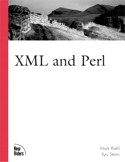|

|
"XML and Perl" uses a series of examples to introduce the reader to the titular combination of technologies. Although not an introduction to either Perl or XML the book would be suitable for the intermediate level programmer of either. The content of the book remains focused on providing comprehensive information on the subjects that it tackles while providing useful examples.
The book is divided into five sections. It starts out by introducing some basic concepts from both Perl and XML. This includes a quick introduction to generating, parsing, searching and transforming XML documents. The second section explains event-driven and tree-based parser architectures and gives examples of their use with different Perl module implementations. The third section goes into details on generating and transforming XML from text files, SQL databases and other formats. The fourth section introduces more complex XML manipulation using technologies such as XSLT and XPath, as well as an introduction to AxKit and the implementation of SOAP-based services and their clients. The final section consists of appendices, references and a glossary.
The book punctuates all its introductions of new concepts with comprehensive examples of their use. These include everything from the DTDs and XML schemas and XML documents used to any generated results and the Perl programs that produce them. Putting all these within the main text of the book can make it a little laborious to read at times, but it also saves having to look any of this up in an appendix when you really need to reference a particular detail. The explanations of each detail of examples are meticulous so that there is never any aspect of an example that will leave the reader baffled if they have been reading through everything in the book.
The writing style is clear and usually concise, although it can be a bit repetitive in places. The standardised layout of the examples makes them excellent to use as an introduction, but once you’ve got the hang of the more basic concepts they are quite easy to skip through to get to the important new material that is being provided in each case. The book also seems that it would make a good reference for where to start in using specific XML-based Perl modules if a reminder was needed.
Overall this is a well-written and well-structured introduction to the use of Perl and XML in combination. The examples given are thoroughly documented and the material covered is more than sufficient to get a competent programmer with a sound knowledge of at least one of the technologies up to speed on how they could be used in a real-world environment.
Table of contents
PART 1 : The Foundation Ch1 : Basics of XML Processing in Perl Ch2 : Now Let's Start Digging PART 2 : Parsing XML Documents Using Perl Ch3 : Event-Driven Parser Modules Ch4 : Tree-Based Parser Modules PART 3 : Generating XML Documents Using Perl Modules Ch5 : Generating XML Documents from Text Files Ch6 : Generating XML Documents from Databases Ch7 : Transforming Miscellaneous Data Formats to XML (and Vice-Versa) PART 4 : Advanced XML and Perl Ch8 : XML Transformations and Filtering Ch9 : AxKit Ch10 : Perl and XML Web Services PART 5 : Appendices App A : What is XML? App B : Perl Essentials
